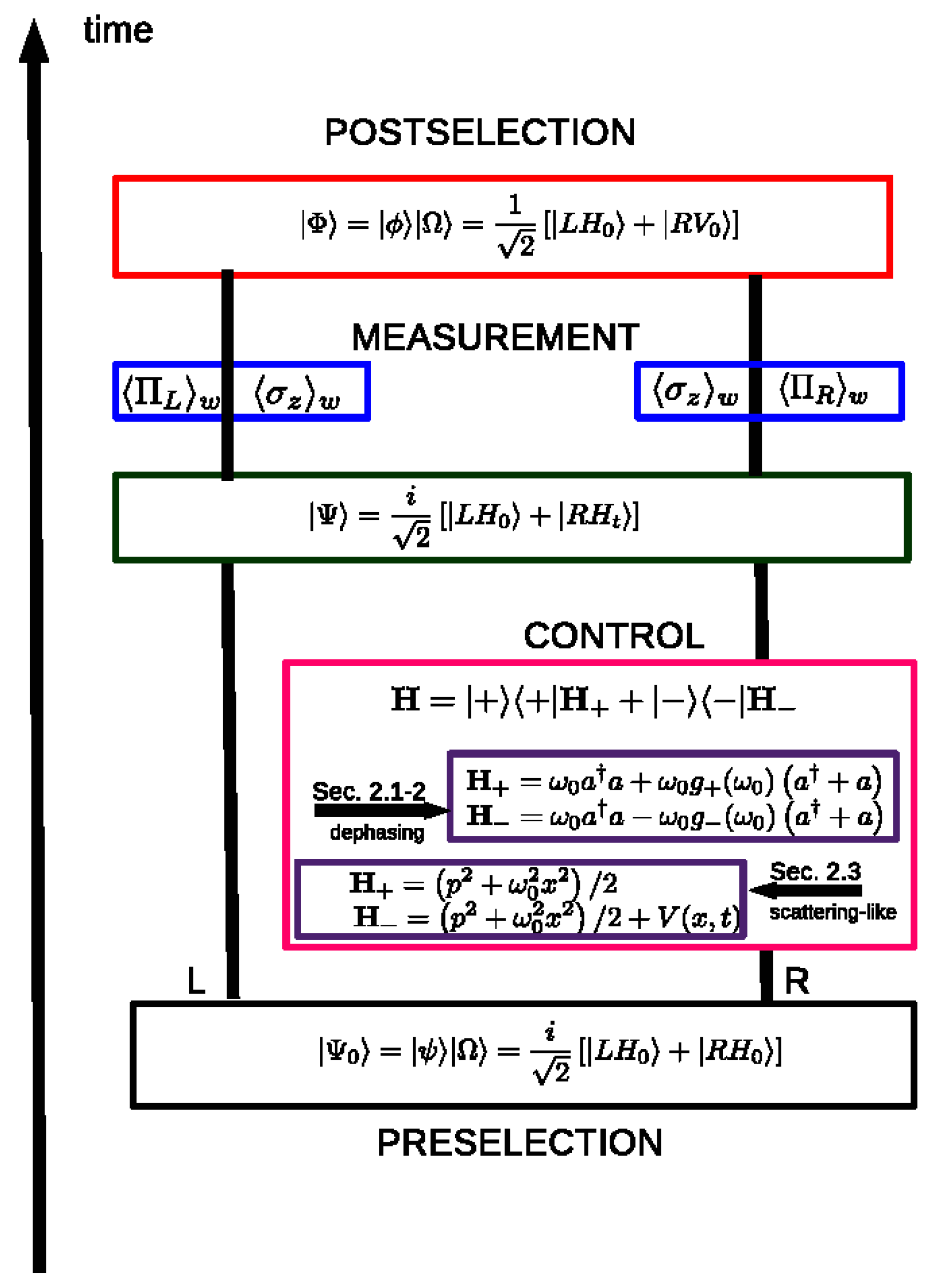Scattering–Like Control of the Cheshire Cat Effect in Open Quantum Systems
Abstract
:1. Introduction
2. Results
2.1. Symmetric Dephasing
2.2. Asymmetric Dephasing
2.3. Scattering–Like Control
3. Discussion
4. Materials and Methods
Funding
Acknowledgments
Conflicts of Interest
References
- Aharonov, Y.; Albert, D.Z.; Vaidman, L. How the result of a measurement of a component of the spin of a spin-1/2 particle can turn out to be 100. Phys. Rev. Lett. 1988, 60, 1351–1354. [Google Scholar] [CrossRef] [Green Version]
- Vaidman, L. Past of a quantum particle. Phys. Rev. A 2013, 87, 052104. [Google Scholar] [CrossRef] [Green Version]
- Englert, B.G.; Horia, K.; Dai, J.; Len, Y.L.; Ng, H.K. Past of a quantum particle revisited. Phys. Rev. A 2017, 96, 022126. [Google Scholar] [CrossRef] [Green Version]
- Aharonov, Y.; Popescu, S.; Rohrlich, D.; Skrzypczyk, P. Quantum Cheshire Cats. New J. Phys. 2013, 15, 113015. [Google Scholar] [CrossRef]
- Cong, S. Control of Quantum Systems: Theory and Methods; John Wiley & Sons: Singapore, 2014. [Google Scholar]
- Aharonov, Y.; Vaidman, L. The two-state vector formalism: An updated review. Lect. Notes Phys. 2008, 734, 399. [Google Scholar] [CrossRef] [Green Version]
- Vaidman, L.; Ben-Israel, A.; Dziewior, J.; Knips, L.; Weißl, M.; Meinecke, J.; Schwemmer, C.; Ber, R.; Weinfurter, H. Weak value beyond conditional expectation value of the pointer readings. Phys. Rev. A 2017, 96, 032114. [Google Scholar] [CrossRef] [Green Version]
- Dressel, J.; Malik, M.; Miatto, F.M.; Jordan, A.N.; Boyd, R.W. Colloquium. Rev. Mod. Phys. 2014, 86, 307–316. [Google Scholar] [CrossRef] [Green Version]
- Richter, M.; Dziewit, B.; Dajka, J. The Quantum Cheshire Cat effect in the presence of decoherence. Adv. Math. Phys. 2018, 2018. [Google Scholar] [CrossRef]
- Alicki, R. Pure decoherence in quantum systems. Open Syst. Inf. Dyn. 2004, 11, 53. [Google Scholar] [CrossRef] [Green Version]
- Breuer, H.P.; Petruccione, F. The Theory od Open Quantum Systems; Oxford University Press: Oxford, UK, 2003. [Google Scholar]
- Schuster, D.I.; Houck, A.A.; Schreier, J.A.; Wallraff, A.; Gambetta, J.M.; Blais, A.; Frunzio, L.; Majer, J.; Johnson, B.; Devoret, M.H.; et al. Resolving photon number states in a superconducting circuit. Nature 2007, 445, 515–518. [Google Scholar] [CrossRef] [Green Version]
- Dajka, J.; Łuczka, J. Origination and survival of qudit-qudit entanglement in open systems. Phys. Rev. A 2008, 77, 062303. [Google Scholar] [CrossRef]
- Alicki, R.; Lendi, K. Quantum Dynamical Semigroups and Applications; Springer: Berlin/Heidelberg, Germany, 2007. [Google Scholar]
- Bratteli, O.; Robinson, D.W. Operator Algebras and Quantum Statistical Mechanics: Equilibrium States Models in Quantum Statistical Mechanics; Springer: Berlin/Heidelberg, Germany, 2003. [Google Scholar]
- Perelomov, A. Generalized Coherent States and Their Applications; Springer: Berlin/Heidelberg, Germany, 1986. [Google Scholar]
- Van Hove, L. Les difficultes de divergences pour un modele particulier de champ quantified. Physica 1952, 18, 145. [Google Scholar] [CrossRef]
- Friedrichs, K.O. On the perturbation of continuous spectra. Commun. Pure Appl. Math. 1948, 1, 361. [Google Scholar] [CrossRef]
- Chen, X.; Ghosh, S.; Xu, Q.; Ouyang, C.; Li, Y.; Zhang, X.; Tian, Z.; Gu, J.; Liu, L.; Azad, A.K.; et al. Active control of polarization-dependent near-field coupling in hybrid metasurfaces. Appl. Phys. Lett. 2018, 113, 061111. [Google Scholar] [CrossRef]
- Lee, B.; Pursley, B.C.; Carter, S.G.; Economou, S.E.; Yakes, M.K.; Grim, J.Q.; Bracker, A.S.; Gammon, D. Spin-dependent quantum optics in a quantum dot molecule. Phys. Rev. B 2019, 100, 125438. [Google Scholar] [CrossRef]
- Dajka, J.; Mierzejewski, M.; Łuczka, J. Fidelity of asymmetric dephasing channels. Phys. Rev. A 2009, 79, 012104. [Google Scholar] [CrossRef]
- Zhang, J.; Liu, Y.-X.; Wu, R.B.; Jacobs, K.; Nori, F. Quantum feedback: Theory, experiments, and applications. Phys. Rep. 2017, 679, 1–60. [Google Scholar] [CrossRef] [Green Version]
- Schwinger, J. The theory of quantized fields. III. Phys. Rev. 1953, 91, 728–740. [Google Scholar] [CrossRef]
- Zeidler, E. Quantum Field Theory I: Basics in Mathematics and Physics; Springer: Berlin/Heidelberg, Germany, 2009. [Google Scholar]
- Ma, J.; Wang, X.; Sun, C.; Nori, F. Quantum spin squeezing. Phys. Rep. 2011, 509, 89–165. [Google Scholar] [CrossRef] [Green Version]
- Perelomov, A.; Popov, V. Parametric excitation of a quantum oscillator. JETP 1969, 56, 1375–1390. [Google Scholar]
- Denkmayr, T.; Geppert, H.; Sponar, S.; Lemmel, H.; Matzkin, A.; Tollaksen, J.; Hasegawa, Y. Observation of a Quantum Cheshire Cat in a matter-wave interferometer experiment. Nat. Commun. 2014, 5, 4492. [Google Scholar] [CrossRef] [Green Version]
- Ashby, J.M.; Schwarz, P.D.; Schlosshauer, M. Observation of the quantum paradox of separation of a single photon from one of its properties. Phys. Rev. A 2016, 94, 012102. [Google Scholar] [CrossRef] [Green Version]
- Duprey, Q.; Kanjilal, S.; Sinha, U.; Home, D.; Matzkin, A. The Quantum Cheshire Cat effect: Theoretical basis and observational implications. Ann. Phys. 2018, 391, 1–15. [Google Scholar] [CrossRef] [Green Version]
- Quach, J.Q. Dual of the generalised Quantum Cheshire cat. arXiv 2019, arXiv:1709.09851. [Google Scholar]
- Peleg, U.; Vaidman, L. Comment on “Past of a quantum particle revisited”. Phys. Rev. A 2019, 99, 026103. [Google Scholar] [CrossRef] [Green Version]
- Englert, B.G.; Horia, K.; Dai, J.; Len, Y.L.; Ng, H.K. Reply to “Comment on ‘Past of a quantum particle revisited”’. Phys. Rev. A 2019, 99, 026104. [Google Scholar] [CrossRef] [Green Version]
- Shikano, Y.; Hosoya, A. Weak values with decoherence. J. Phys. Math. Theor. 2009, 43, 025304. [Google Scholar] [CrossRef] [Green Version]
- Kato, T. Perturbation Theory for Linear Operators; Springer: Berlin/Heidelberg, Germany, 1980. [Google Scholar]
- Łobejko, M.; Mierzejewski, M.; Dajka, J. Interference of qubits in pure dephasing and almost pure dephasing environments. J. Phys. Math. Theor. 2015, 48, 275302. [Google Scholar] [CrossRef]

© 2019 by the author. Licensee MDPI, Basel, Switzerland. This article is an open access article distributed under the terms and conditions of the Creative Commons Attribution (CC BY) license (http://creativecommons.org/licenses/by/4.0/).
Share and Cite
Dajka, J. Scattering–Like Control of the Cheshire Cat Effect in Open Quantum Systems. Quantum Rep. 2020, 2, 1-11. https://doi.org/10.3390/quantum2010001
Dajka J. Scattering–Like Control of the Cheshire Cat Effect in Open Quantum Systems. Quantum Reports. 2020; 2(1):1-11. https://doi.org/10.3390/quantum2010001
Chicago/Turabian StyleDajka, Jerzy. 2020. "Scattering–Like Control of the Cheshire Cat Effect in Open Quantum Systems" Quantum Reports 2, no. 1: 1-11. https://doi.org/10.3390/quantum2010001




